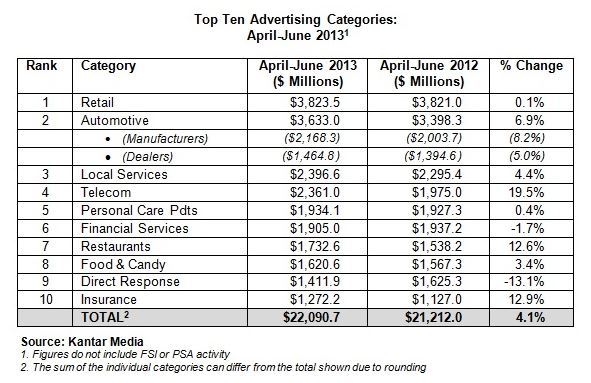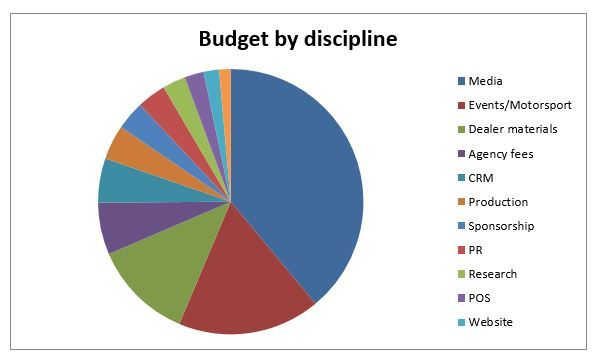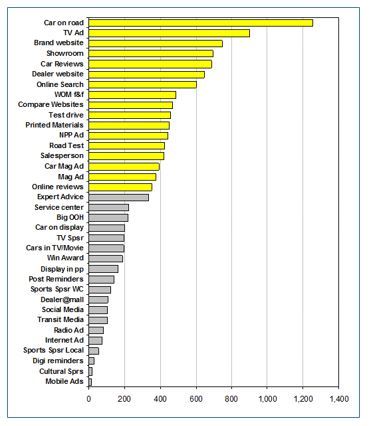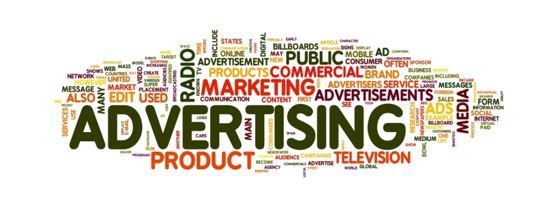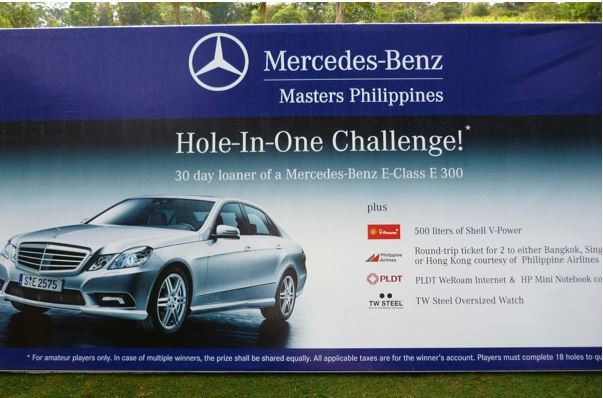Apart from steel the biggest single cost that goes into each car sold is marketing.
9.2% of all the World’s marketing spend is spent on automotive (Nielsen Q2 2013).
The following table gives you an idea of the scale of the expenditure – we might surmise that Automotive expenditure may be approximately $14.5 billion in the next year (give or take small change).
So, given the size of the expenditure and the benefits of making even a few percentage point improvements in return on marketing investment, or just straight savings, you would expect marketing procurement people in automotive to be amongst the best in the business, right?
You would expect procurement in automotive companies to be at the leading edge of marketing procurement best practices, embracing change, and leading the whole marketing discipline forward.
And, some are. But equally, some really are not.
In this article we will look at some of the problems and six top tips that could help drive improvement of the procurement of marketing services in automotive companies.
The cruel facts are that most automotive marketing procurement treats each marketing discipline as discrete, and they do a series of cost focussed deals, without linking them, or building an integrated marketing ecosystem. There is not too much integrated marketing procurement on offer! (Read about integrated marketing procurement here)
So, not a lot of integrated procurement despite the fact that 31% of global marketers believe that they could gain a 20% improvement in marketing efficiency if they were better integrated, and 68% of marketing directors say they believe marketing integration is their biggest challenge! (See here for more details)
The pie chart below represents a fairly typical split for a large global automotive manufacturer. It does not factor in dealer media spend and activity, just spend by the manufacturer. It is for illustration only.
Let us have a think about what marketing procurement at a large automotive manufacturer could do to drive sales and save money.
#1 INSIGHT: CHANGE SPEND PROFILE TO SAVE MONEY
The first thing to note is that the expenditure is not aligned with the most effective consumer channels. You can read more about how to measure what are the most effective automotive channels here, but the chart below shows the ranking of most effective channels.
The smart automotive marketing procurement person will realise that getting the different marketing departments to spend the right amount will save the most amount of money. Working with their HQ counterparts and putting in place the marketing effectiveness and measurement systems must be priority #1.
For those automotive clients that have several brands, a common evaluation framework across all brands is clearly an advantage.
Here is a tip: never ever, ever, let anyone outside the organisation have responsibility for budget setting and the data. One President of a large manufacturer put it like this: “Data is like blood to an auto manufacturer”. If you give responsibility to an outside organisation like a modeller or an agency’s econometric department, you will be wedded to them for ever, it will be more expensive than you think, your data may not be safe, and you have moved accountability further away from your organisation, rather than nearer it. Data is like blood, you would not give that away would you?
#2 FIX YOUR MEDIA AGENCY
You will see the Media proportion of the budget is typically the largest. This budget is handled by a media agency. If you have different media agencies you have lost leverage, and lost the ability to bring together data, best practise, and global trading clout with large vendors – especially those in the digital world like Google, Facebook, Yahoo etc etc.
“Fixing” your media agency is not about getting the lowest media cost, or the lowest fees. You need to create a platform or a foundation onto which you can build the rest of your marketing ecosystem.
Some of the things you should be thinking about beyond price and fees are as follows:
- What content can be leveraged from the media owners?
- What event and sponsorship access can, and what PR can be leveraged from the media owners?
- What data does the media agency have that I can use, what can they get from the media owners?
- What other research can be leveraged through my expenditure, to save against my research budget?
- What access to media owner digital and social media communities can I leverage with my expenditure?
- How can the media agency help me with data for my marketing measurement and evaluation?
- What other services do the media agency offer that I want, and can be leveraged through smart contractual and fee negotiations?
- How can I ensure the media agency are brilliantly integrated with my digital, social content, event, PR, CRM, creative and production teams?
- What IT and data systems integration is required now, and in the future?
- How can I ensure I get the service I require in the Holding Company and Network domain? Will I get and keep the best staff?
- What are the competitors doing with their media agencies – how do I gain a competitive advantage?
- Do I trust the media agency not to “resell” my digital performance data? How can protect my data?
A strong media agency is an essential platform and foundation for an automotive marketing services ecosystem. Just make sure that any review is not driven by media auditors driving their own methodologies, and making it a pure price shoot-out, because they do not know about digital, data, production, content or integration!
#3 CREATE A CONTENT ENVELOPE
A content envelope is your production system (it sends the content out, and gets the response back, from the consumer). To feed social and digital media we need more high quality content than ever before. The good news is that technology allows us to create it cheaper and distribute it easier, than ever before. But you need the right structure (in-sourced versus out-sourced, decoupled or not?) and the right marketing technology, applied correctly to benefit from the advantages on offer.
A lot of production systems just send out content once it is made. Many also do not monitor the response to each piece of communication, so no-one knows whether it has worked or not.
Our work with the creative, production, digital, and media disciplines has allowed us to develop tools like the Flock Content Calendar Creator (FCCC) to fill the gap between the production companies software and that of the media and creative agencies. See here for details on our FCCC.
If you do not fix your production system you will never be able to eliminate wastage from the production budget, nor will you be able to look at different ways of working with your creative agencies, with the resultant savings to be made from agency fees. Also, with a great production platform you will be able to find efficiency in the production of POS (point of sales), and dealer materials.
Whilst getting great production benchmarks takes the longest time, without them any change program is doomed to failure. We know of one manufacturer who just could not get a handle on the production benchmark information well enough to push through a production decoupling exercise.
Whilst consolidating all production is probably a good idea, deciding how much to decouple and outsource/insource will be highly dependent upon your culture, your starting point, and your appetite for change.
#4 DESIGNING A STRUCTURE FOR SOCIAL/DIGITAL/CRM/PR
Do you need separate internal departments and external resources for:
- Social
- PR
- CRM
- Websites
Would it make most sense to consolidate PR and Social together?
Or, Social and Websites?
Or, would Websites sit best alongside CRM?
Or, do CRM and Social sit best together offering a single view of the consumer?
There is no right answer of course, with strong pros and cons on each side. Currently different manufactures have quite different approaches, but whether they were actually designed in the way they have ended up is open to debate…
Have a look at the effectiveness of these channels (see chart above) though, and you may find a strategic benefit (as well as a cost saving) in closer alignment and integration of some of these disciplines. The point is to think about it, analyse it, work with marketing and the markets, but make a positive decision, not just sleepwalk into annual negotiations with a fragmented set of external agency resources.
Very often corporate PR and brand/model marketing PR are siloed in car manufacturers. This makes little sense from a consumer perspective, and can cause real issues in the event of emergency such as a recall. Pushing for consolidation may not make the Marketing Procurement professional many friends, but is the logical solution in many situations.
#5 HOW MANY CREATIVE AGENCIES IS ENOUGH, HOW MANY IS TOO MUCH?
In general most major automotive companies have consolidated their creative responsibilities into a lead global agency, because they are pushing a globally consistent brand message. This makes a great deal of sense if you have the right agency. Not so much, if you do not…
However, how this agency services your business across the world can be examined much more closely, and should be dictated by the needs of the business and brand in the future:
- Can you produce materials from a single global hub, to be distributed and implemented by a production partner and your media agency?
- Do you need a regional hub structure to help manage different regional structures and requirements within your business? Is your brand different in different markets, or your market so different to warrant a separate agency? Where should you house global and regional hubs?
- Do you need to have agencies in every market to serve your local sales companies? Or, will this just breed cost, and a lack of brand control as the natural tendency of a local marketer and a local agency is of course to create work and their own materials.
The scope of the agency should also be closely mapped against what will be required in the future rather than what has been developed in the past:
- Will production be decoupled from the creative agency?
- Will the agency be tasked with POS, brochures and other creative materials?
- See point #4 about digital. If the creative agency does not originate the digital creative work, how can you build the requirement to integrate with the digital agency into their contracts, ways of working and rewards?
- Getting great metrics and KPIs for your creative agency’s incentives/malus clauses based upon the digital, social and mobile world, as well as ads and banners is pretty important to drive change in their organisations. Are your agencies incentivised to drive social and web-traffic?
The decision to move or consolidate creative duties is a highly emotive one with the national sales companies. They believe they are losing control and independence, by using or not choosing their own agency. Saatchi & Saatchi, working for Toyota, consolidated nine markets when Simon Francis, CEO of Flock Associates, was then CEO. Each one was difficult. Understanding how to win over the local sales company is essential to any change of creative responsibilities, and it is as much emotional as rational, as much the “how” as the “what”…
#6 DECOUPLING STRATEGY AND EXECUTION FOR SPONSORSHIP, EVENTS, & DEALER
The car dealerships are very important in the customer journey to buying a car. Seven of the top fifteen most influential contacts shown in the chart earlier in this article are dealer related. Many events link to dealer and sales event that are prescribed locally, against local market conditions. In many markets local sponsorships are also undertaken. All of these are necessarily executed locally.
Very often these local dealer ads/promotions/events/sponsorships are not executed against a strategy, are not measured for success, and very often a lot of money is wasted in these areas.
We have also seen the random sponsorships, poor merchandise and promotion and we have wondered, like you, how it was allowed!
Creating “Flexibility within a framework” is a pragmatic approach to controlling this large area of expenditure. Think about decoupling strategy and execution. By this we mean create very tight guidelines for brands/models/activities centrally. Give good creative toolkits to allow the local markets to execute against the guidelines, but with the freedom to deliver against their local market needs. Make sure that you put great measurement & evaluation criteria in the guidelines and mandate accountability measures!
Try and control the approval process, or release of materials, or use co-funding as means to gain control over execution.
With guidelines in place, great quality creative materials that can be adapted, great measures in pleasure, and an approval system you will not stop activity but you will militate against brand-damage, and over time can grind out improvements. It is slow and heavy work to change cultures, do not expect quick wins in this area!
So, there is a little insight into Integrated Marketing Procurement for the automotive category. If that little insight was applied and saved the automotive industry just 5%, that would be $725,000,000 or 5,410 Aston Martin DB9’s or 93,008 Kia Picanto’s. The choice is yours!
If you would like any more details on our marketing procurement services please see the website here or give us a call here
Comment Policy: Thanks for visiting the Flock Blogging page, where we welcome your comments. Since this is a moderated blog, all comments will be reviewed prior to posting. As a result, there will be a delay in the posting of comments and not all comments will be posted. Comments may also be removed after they are posted. Thank you for your understanding.




